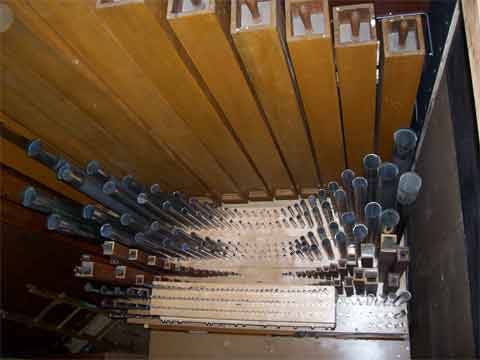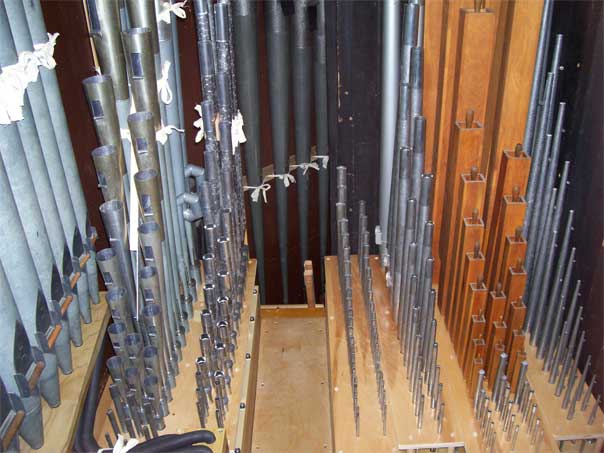
The Bream organ is a perfect example of how, when it comes to pipe organs, smaller is often better. The original organ was built in 1913 by the Estey company of Vermont. A reasonably sized two manual organ, the Estey was installed within the confines of the original chancel, which was smaller than it is currently. The original organ used tubular pneumatic action, with the usual Estey ventil windchests. Being a typical organ of the early 20th century, the organ’s original stoplist was almost all at 8’ pitch. In the late 1930s, the Estey firm was called back to electrify the action, and supply a detached console. As far as we know, the stoplist was not changed. As musical tastes changed, the organ was deemed to be inadequate, and in the mid 1960s work was carried out to expand the organ. A new Positif section was hung on the wall in front of the organ, and alterations were made inside the organ, the nature of which can’t be accurately determined at this point. This work proved not to be satisfactory, and the organ was rebuilt again in the mid 1970s. During this rebuild, a new three manual console was provided, and the new material from the 1960s work was squeezed into the main case of the organ. The result was that the original 1913 windchests, by now totally obsolete, were left in place, and several direct-acting electric chests occupied every square inch of space available. The large number of pipes created very poor service access; indeed, one had to gingerly walk on the tops of pedal pipes to get inside the swell box. The pipework was a mix of 1913, 1965, and 1975 vintages, each having little to do with the other. By the late 1990s, the increasingly noisy Estey chests were becoming unreliable, the console was starting to have problems, and there was general dissatisfaction with the tone and action of the organ. Our solution was to put the organ on a diet, and strip away anything that wasn’t considered essential. With regards to the mechanism, we asserted that a large part of the dissatisfaction was due to the mix of mechanism from different periods. During our rebuild, the organ was completely removed, down to and including the floor frame. All windchests were discarded and new direct-acting electric chests were built in house; the console and electrical systems were rebuilt with new solid state electronics. Great care was given to create an instrument which would be as easy to work on as it would be fun to play- spacious walkboards and copious lighting are provided throughout. A new tonal scheme kept many of the old pipes, albeit rearranged, to provide the long missing cohesiveness. The result is an organ which, while somewhat smaller than its previous incarnation, has received unanimous praise from the organ community. (And just wait until they hear the Antiphonal someday!)



16’ Double Melodia
8’ Principal
8’ Melodia
4’ Octave
4’ Hohlflote
2’ Mixture III
8’ Trumpet (Sw.)
8’ Cromorne (Sw.)
Swell to Great 8’ and 4’
SWELL
8’ Stopped Diapason*
8’ Gemshorn*
8’ Gemshorn Celeste
4’ Flute
2’ Piccolo
II Cornet
16’ Cromorne TC
8’ Trumpet
4’ Clarion
Tremolo
ANTIPHONAL (prep.)
8’ Gedeckt
4’ Spitz Principal
2’ Fifteenth
II Mixture
8’ Solo Trumpet
PEDAL
16’ Bourdon*
16’ Lieblich Gedeckt
8’ Pedal Principal
8’ Major Flute
4’ Choral Bass
32’ Cornet III
16’ Contra Trumpet
4’ Cromorne (Sw.)
Great to Pedal 8’ and 4’
Swell to Pedal 8’ and 4’
Antiphonal to Pedal 8’
*Original 1913 Estey stops

